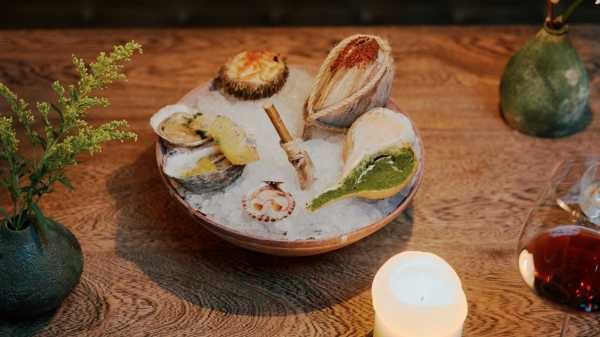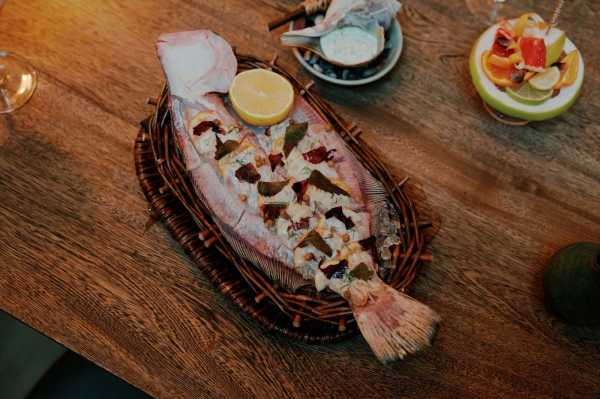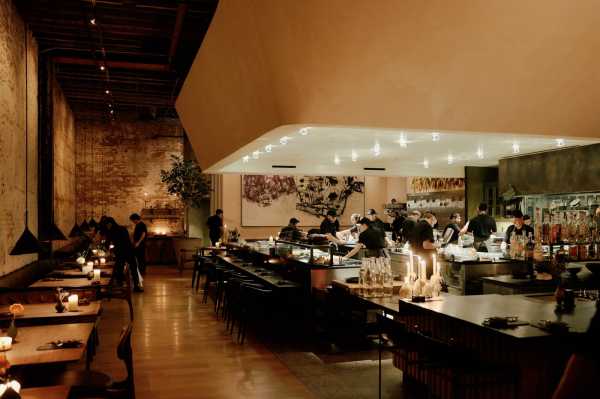
Save this storySave this storySave this storySave this storyYou’re reading the Food Scene newsletter, Helen Rosner’s guide to what, where, and how to eat. Sign up to receive it in your in-box.
Midway through a recent meal at Ilis, a new, dramatic tasting-menu restaurant run by the Danish chef Mads Refslund, I looked up from a piece of carmine-red bigeye tuna loin, mirror-glazed in stone-fruit vinegar and only barely cooked, atop a square of kombu, and wondered, for a moment, exactly where I was. I knew, of course, that I was in Brooklyn’s Greenpoint, but there was something about the evening that was disorienting, that smacked of elsewhere. Much of this could be attributed to the sheer size of the space, a cavernous former warehouse with wood-beamed ceilings and exposed-brick walls. Loungey sofas and oversized dining tables form a narrow perimeter around a centerpiece open kitchen, where a phalanx of cooks moves in focussed rhythms. Some of the feeling, I suppose, I could credit to the cumulative effects of a sumac-and-rum cocktail, followed by a zingy combination of Genziello (a gentian limoncello), grapes, and navy-strength gin. “I feel like we’re in Mexico City,” one of my companions said, unprompted, in an extraordinary act of psychic synchronicity. “Lisbon,” another corrected. “Definitely not New York,” the third agreed.
Ilis
150 Green St., Brooklyn
(Tasting menu $195-$295.)
The placelessness that suffuses Ilis is also, I suspect, part of the design. Much has been made of Refslund’s involvement with Noma, the ultra-influential Copenhagen restaurant that became famous for turning hyperlocal, often bizarre ingredients into bite-size, highly specific documents of the natural world outside the restaurant’s doors. There’s a bit of Noma’s DNA at Ilis, in the audacity of its creative ambition, and the reverence it has for cooking as a form of art. But where Noma, at least in those early years, was all about anchoring the ephemerality of food in concrete notions of place and time, Ilis seems to be committed, body and soul, to abstraction. “Mads loves the idea of using part of an animal as the tool to eat it,” a chef-cum-server said, as she laid down a mousse of giant whelk with chive oil and a buttery foam. The mixture had been piped into the whelk’s own shell, and was presented with a spoon whose bowl was made from the whelk’s dried foot. Are there giant whelks swimming around New York? Is there something profound about making a whelk taste, quite pleasingly, like sour-cream-and-onion chips? This isn’t Noma—Refslund seems to be only passingly interested in history, place, or narrative; the restaurant promises, instead, to explore texture, form, and temperature. (Ilis is a portmanteau of ild and is, the Danish words for “fire” and “ice.”)

A whole fluke served two ways—half as a ceviche and, later, half broiled—is the restaurant’s most literal interpretation of its theme of fire and ice.
A meal at Ilis is remarkable, full of fantastical flourishes and clever manipulations, and unbearably beautiful ingredients (many of them displayed, with nonchalant opulence, on the counters ringing the open kitchen). There’s something of a sustainability story being told—virtually all of the ingredients are found in North America, many are foraged, and the restaurant eschews beef and the meat of most other large mammals—but it gets lost amid an over-all emphasis of spectacle. A meal begins with the arrival of an ice-laden cart, wheeled to the table, on which rests a Seussian array of seafood and other mollusks: oysters on the half shell dressed with bright fruit flavors; spiny sea urchins on the half shell filled with briny mousse; those dramatically self-utensilling whelks. Most ludicrous, and most exciting, are enormous whole clamshells, sealed shut with wax save for a tiny opening at the lip that’s been dusted with salt and spices, out of which you sip a chilled broth of clam liquor and fresh tomato juice—a virgin bloody Caesar, if we’re going to be unimaginative and Canadian about it, but this is about the vessel, not its contents. Placing one’s lips on the opening and swigging from the heavy shell feels heady and piratical, almost embarrassingly like a kiss.

The enormous dining room treats the kitchen as a centerpiece.
Some of the dishes I tried at Ilis are among the most satisfying I’ve had in ages: that glazed bigeye tuna, which melted on the tongue into a glossy slick of seawater and fat and sweetness; or a stern-looking dessert porridge made of rye and dark chocolate (“Mads doesn’t like desserts to be too sugary”), whose every bite unfolded with extraordinary subtlety. The cocktails, created by Bobby Murphy, are particularly inspired, with the extensive list organized according to their fruit and vegetable ingredients. One course included the salad of my dreams: a rosette of cabbage leaves, dressed in a creamy sauce and studded with enormous orange trout roe (not, one presumes, extracted from the tender whole trout served alongside it, though the two were certainly having a conversation). Some dishes stood out simply for their underperformance. Antelope tartare, intriguing in theory, was flat-tasting and underseasoned; its generous portioning seemed more like a burden than a gift. A whole fluke was presented early in the meal, lying flat on a plate of ice with the exposed side prepared as a ceviche, which was overwhelmed by enormous hunks of citrus interleaved with the thin-sliced flesh. Toward the end of the meal, the fluke returned, its intact half now viciously broiled—the most literal representation of the restaurant’s fire-and-ice motif—and, oh, it was magnificent, the flesh butter-sweet and the skin paper-crisp. We tore into it rapturously, marvelling that the same fish which had so clumsily started our meal could lead us to the finish in such glory.

A cocktail made with pawpaw, a creamy fruit native to North America.

A citrus Martini from the cocktail menu, much of which is organized according to the drinks’ fruit and vegetable ingredients.
There is no delineation between front-of-house and back-of-house at Ilis: chefs act as servers, bartenders run their own cocktails, and many courses are finished tableside. The proceedings are conducted with an almost ecstatic self-seriousness that frequently tips over into downright silliness. I realized, quite quickly, that the slightly neurotic diner would do well to let go of a certain amount of control. When I arrived at the enormous wrought-steel doors of the restaurant, I wasn’t entirely sure what to expect, and I’m honestly still not entirely sure what I experienced. I was pretty certain that I’d booked the shorter of the two tasting menus ($195 per person), a seven-course meal, instead of the pricier option ($295), in which you get to eat everything. (There’s a still more abbreviated menu, served à la carte at the bar, for walk-ins.) But, by the time dishes started rolling in, without our party having seen a list of items from which to pick, I started to wonder if we’d been upgraded.
Helen, Help Me!
E-mail your questions about dining, eating, and anything food-related, and Helen may respond in a future newsletter.
Although the dishes were cheerfully explained as they were dropped, there was no printed menu to refer to, and so pleasures blur together in my memory. Was there something pairing bergamot with sea scallop? Was that tender, golden-skinned chicken smoked or just slowly roasted? The “Field Guide,” a slim hardcover volume presented to diners at the beginning of each meal, which outlines Ilis’s culinary and sourcing philosophies, clarified little. (The “How to Use This Book” page that opens the guide clarified even less.) I tried to count courses, but lost track somewhere around a dish of Brussels sprouts “on the cob” (spice-encrusted, fantastic, I ate them off the stalk with the gruffling intensity of a pig rooting for truffles). The bill, when it came, was a handwritten scrap of paper specifying one number for “food” and another for “beverage.” But what’s a few hundred dollars and a half-dozen courses between friends? Whirling in the vortex of Refslund’s culinary vision, one has nothing else to do but give in. ♦
Sourse: newyorker.com